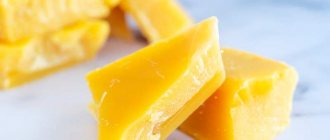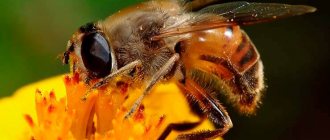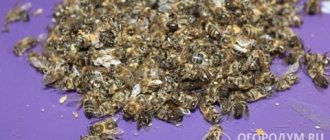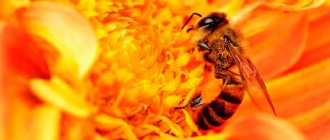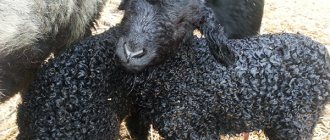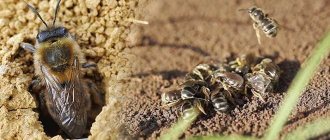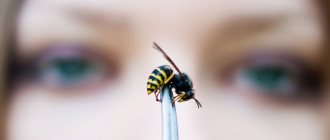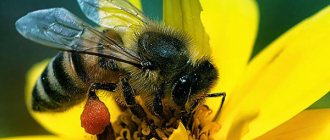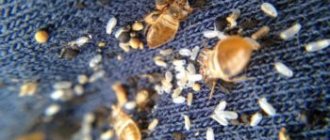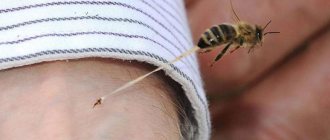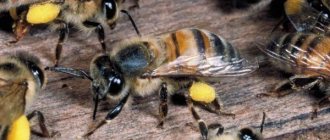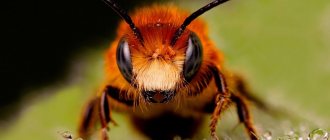What does a bee's honeycomb look like?
The question of what honeycombs look like has long been of interest to humanity, in particular to biologists, mathematicians, physicists and simply curious people.
Honeycombs consist of many cells, each of which is 6-gonal in shape with smooth edges.
Scientists have identified 2 reasons for this:
- The hexagonal structure allows cells to be placed to minimize their overall perimeter and optimize the consumption of building materials.
- This form is the most durable.
Cell material
To build cells, insects independently produce special wax. There is simply no more suitable material for these purposes, because beeswax has the following properties:
- it is so soft that it is easy to give it the desired shape;
- after hardening, it acquires strength and retains its outline well;
- is durable;
- resistant to oxygen;
- has an antimicrobial effect, preventing the proliferation of harmful bacteria.
No building material created by human hands has such a set of characteristics!
Types of honeycombs
There are different types of cells: bee, drone, transitional, queen cells.
Bees
Such honeycombs are designed for breeding worker bees and storing honey and bee bread. They are characterized by high strength, although they are made of plastic wax.
To build 1 cell, an insect spends about 13 mg of wax. The horizontal diameter of the new structures is from 5.3 to 5.7 mm, the depth is from 10 to 12 mm. Over time, their volume decreases, because Insect larvae shed their cocoon several times, which sticks to the walls. As the internal free space decreases, smaller individuals appear in the combs, which becomes obvious already in the 3rd generation.
6 days after the larvae emerge, the bees seal the cells with lids made from a mixture of wax and pollen.
Such superstructures have a porous structure that prevents the movement of air flows in the internal cavities.
Drones
These cells are designed for breeding males and storing honey reserves.
The average diameter of newly built cells reaches 7 mm, and the depth is 14.5 mm. Their production requires 2.3 times more wax. Bees also seal them with lids, which have a loose texture and consist of glued grains of wax.
Transitional
These elements are located between the bee and drone cells. They provide a smooth transition between ridges. The cells of such honeycombs can look different: they are generally irregular in shape and include 4–10 corners. This allows you to change the spatial orientation of subsequent ridges.
Queen cells
There are a small number of enlarged cells designed for breeding queens. After the birth of the oviparous female, insects destroy such structures.
Performance
The productivity of a bee colony depends on many factors, so any estimate will be approximate. A standard hive frame measuring 43.5 by 30 cm can accommodate about 8,000 bee cells on both sides. Considering the average cell volume (0.28 cm3), you can get a little more than two liters of honey from the frame.
For good profitability of the apiary, the beekeeper should control the number of frames installed - there should always be enough of them to expand the nest with bees. Lack of space leads to delayed laying of eggs by the queen and a decrease in the number of worker bees. During honey collection, free areas are also needed to place the extracted nectar, otherwise insects may remain inactive or begin to swarm.
The structure of a honeycomb
In modern hives, the honeycomb structures are placed on frames, which are then installed parallel to each other in the interior of the hive.
Framework
The honey frame is the main structural element of the hive. It is the foundation for building up the honeycomb. It can be easily taken out to check bees for pathologies or extract honey.
Honeycomb
This is a massive structure formed by hexagonal prismatic cells located on both sides of the hive frames. It is convenient to view them on a flat surface.
Where does the wild bee live?
The favorite natural habitat of the sang is forest plantations and forest areas. The main condition is distance from roads, industrial centers, and human settlements.
The ideal place for a family is a hollow. The nest can also be built between tree branches in a dense crown, in crevices of walls or mountains. Burrows dug in the soil are also suitable for settlement.
Sometimes a convenient place to live is close to a person. A gap under the roof of a barn or house, the space between frames, etc. is suitable.
A place for a family home should be suitable in many ways. The most important of them is the presence of a constant source of water nearby.
Composition of honeycomb
The main component of honeycombs is beeswax, secreted by special glands on the abdomen of working insects. It is stable and waterproof, which is why it is used to rebuild the cell frame. The chemical profile of the wax includes approximately 71% esters, 15% hydrocarbons, 6% fatty acids.
The cellular cavities are filled with honey, about 97% of the mass of which is an aqueous solution of sugars. The remainder includes a small amount of proteins, vitamins, minerals, and bioactive compounds.
Physical basis of the design
Bee houses are one of the most perfect buildings in the world of entomology. All compartments are connected without gaps. The execution requires the same amount of wax, which the “builders” produce themselves. The building material includes valuable and useful components: propolis, minerals, fatty acids, resins, esters. It does not break down with water, is stored for a long time and retains its properties. Only families where there is a producer of offspring - a queen bee - nest.
It is because of its unsurpassed structure that the honeycomb structure is used in construction and the production of building materials.
The process of constructing a honeycomb
First, worker bees prepare the hive space by covering its walls with a thin layer of sticky propolis. This substance consists of plant resins and wax. Insects use it at various stages of construction to cover cracks and holes.
With the help of their mandibles, bees crush the wax they secrete into small balls, which are placed from top to bottom in a checkerboard pattern. Under the influence of the heat generated by insects during work, the wax granules melt. Gradually they become flat and take on the shape of a regular hexagon. Bees make internal cavities in the granules, carefully controlling the depth of the cells and the width of the walls.
Cellular walls are highly durable and can withstand 30 times their own weight. Honey is stored in the cavities of the upper cells, pollen is stored in the lower cells. Behind them are brood combs.
Origin
Bees are a group of flying insects. It belongs to the order Hymenoptera. Appearance, behavioral characteristics, and vital functions are studied by the science of “Apiology.” The ancestor of honey plants is the predatory wasp.
The transition from insectivorous feeding to pollen eating presumably occurred gradually through the consumption of insects that pollinated plants and were covered in pollen. The oldest fossilized bee was found in amber in 2006. The age of the find dates back to the Cretaceous period (100 million years).
The word “bee” itself has ancient Slavic origins. This form of designation is onomatopoeic “bučati” - “to buzz”. Any insect of this group has two pairs of wings, a proboscis, a sting, and glands with poison.
Is it possible to eat honeycombs?
The entire honeycomb, including the raw honey and wax base, can be eaten. However, before use, you should consult your doctor, because... the product contains potential allergens.
Contraindications for use
Natural honeycomb is considered a safe product, but raw honey may contain the spore-forming bacteria Clostridium botulinum. These microorganisms produce neurotoxins that are especially dangerous for pregnant women and young children.
The product should not be used by patients with gastrointestinal pathologies and intolerance to the chemical components of raw honey. Healthy people are not recommended to eat large quantities of the product to avoid digestive upset.
Honey gum
When the honey ripens, the bees seal the cells with lids made from a mixture of pollen, propolis, and wax. Such superstructures are called zabrus, or honey chewing gum.
Bee baling is useful for the following conditions:
- development of inflammatory processes;
- pathologies of the musculoskeletal system;
- diseases of the oral cavity;
- reactive and chronic diseases of the nasopharynx;
- acne.
Honey gum has a sedative effect, helping a person cope with stress and reduce the symptoms of neuropsychiatric diseases.
Contraindications and restrictions
In addition to allergic and asthmatic reactions, honeycombs can cause some harm to health if consumed in excess. High levels of sugar and hydrocarbons are quite capable of causing tooth decay. But this is only a minor problem compared to the fact that this product can be carcinogenic. It turns out that consuming honey may not be beneficial, but quite the opposite - cause health problems.
Depending on the area, the cells may turn out to be unsuitable for consumption - emissions from enterprises, chemical treatment of fields and summer cottages lead not only to spoilage of sweets, but also to the death of entire bee families. So, if it is not clear why it stings in the mouth or nasopharynx when consumed, there is a high probability that the product is spoiled.
Women who are pregnant should not use comb honey or any honey at all. The absorption of this product decreases during pregnancy, which can lead to negative consequences for the body.
Important! When heated, honey can release carcinogenic substances from its composition. Therefore, those who like to drink tea with honey should use only a proven product.
How to get honey from honeycombs?
To extract honey, beekeepers often use a honey extractor, the basic element of which is a centrifuge. The honeycomb is unsealed and placed in a device that, when turned on, begins to rotate rapidly. Under the influence of centrifugal forces, liquid honey gradually flows out of the cells and is collected in a special tank.
Many beekeepers believe that obtaining honey without centrifugation is unprofitable.
However, it can be done like this:
- Carefully cut the honeycombs from the frame, break them into small pieces and place them in a bucket.
- Grind the product using a wooden masher.
- Strain the resulting mixture through cheesecloth.
This process takes a lot of time. To reduce the number of manipulations, you can simply cut the cellular structure with hot scissors and let the honey drain naturally into the container.
Storage
Beeswax
Considering the great benefits of honeycombs, it is important to be able to preserve their qualities for as long as possible at home. Propolis in comb honey acts as an excellent natural preservative.
Increased resistance to most microorganisms gives the honeycombs a fairly long shelf life.
Among the threats to bee honeycombs removed from the hive, it is worth highlighting the main ones. These include:
- Moisture. When the permissible humidity limits are exceeded, the honey in the combs begins to deteriorate. Therefore, the humidity in the honey storage room should not exceed 60%, and it is also necessary to ensure sufficient ventilation.
- Sun. Exposure to direct sunlight and high temperatures accelerates the destruction of honey in honeycombs. So honey needs to be removed from the sun and heat.
- Insects. The most common pest here is the wax moth. She is especially active in the hot season. Well-ventilated rooms with an air temperature no higher than 10°C protect honey in combs from such insects.
- Mold. It develops when the humidity is too low, and it is quite difficult to get rid of it, so you should not allow it to appear.
After considering the dangers that threaten honey in a honeycomb, protecting it from them will not be difficult. The optimal storage conditions for honeycombs are a suitable temperature - from 3 to 10°C.
Also, when storing honey, you should know that it absorbs foreign odors well, so you need to keep it separate from strong-smelling products.
Storage containers should always be covered with a lid. Honey in honeycombs, if all conditions are met, can be stored in a liquid state for up to 3 years.
Use in folk medicine
The product contains more than 280 bioactive substances that are potentially beneficial to humans. Thanks to this composition, they are widely used in folk medicine.
Honeycombs have several beneficial properties:
- improve the body's immunity;
- stop inflammatory processes;
- stimulate peristalsis and normalize digestion;
- help strengthen the walls of blood vessels;
- suppress the activity of pathogenic microbes and potential allergens;
- clears the airways;
- activate blood circulation;
- increase male potency.
The product is used in cosmetology. It is added to nourishing creams for the face and body.
Some beneficial properties of the product have been scientifically proven. Studies demonstrate that the components in its composition help reduce the risk of developing diabetes, heart and neurodegenerative diseases, and various types of cancer. The product contains beeswax, which includes heart-healthy long-chain fatty acids and alcohols. These compounds help lower blood cholesterol levels.
Characteristic
Wild individuals have the same body structure as domestic ones:
- two pairs of wings;
- head;
- breast;
- belly;
- paws;
- proboscis;
- sting.
They are also characterized by a hairy covering and a chitinous skeleton. Excellent vision is evidenced by the presence of two compound and three simple eyes. Both females and males have antennae in varying numbers. This organ of smell is endowed with increased sensitivity. Serves to determine the level of heat, humidity, and the presence of carbon dioxide in the nest.
Taste buds are located on the proboscis and paws. The lower lip transformed into a proboscis. The top one looks like a chitinous plate. The sting is located at the end of the abdomen. There are a few nicks on the surface. Therefore, after a bee stings an enemy, it lingers in the body. The bee itself always dies.
What do they eat?
Wild honey plants, like “noble” ones, eat nectar and pollen collected from flowering plants. They prefer trees such as linden and bird cherry. Among the shrubs – viburnum. Herbs include clover, oregano, thyme, angelica, mother and stepmother, chicory, mint, sage.
Where do they spend the winter?
“Free” honey plants spend the winter in their nest. With the onset of the cold season, the house is cleaned. Bees clean out debris, expel drones, and seal honeycombs with wax plugs. Protecting their home from drafts and excessive humidity, insects seal the cracks with propolis.
By the end of autumn, honey plants gather in a large lump. Its density depends on the ambient temperature. The colder it is outside, the denser they cluster. Insects of the upper tier are inactive. Inside, individuals actively move, generating heat. The “core” temperature reaches 350.
Gradually the bees change places. Individuals, moving inside, warm up and begin to generate heat themselves. The family, using food supplies, slowly moves up.
For successful wintering the main conditions must be met:
- strong numerous swarm;
- honey supply;
- preparing the house (absence of draft and dampness);
- peace and quiet around the winter hut.
When metabolism slows down in cold weather, one bee needs up to 7 mg of food per day.
What does a forest bee's nest look like?
The houses of wild families are located in tree hollows. The internal structure always exactly matches the size, shape of the “room” and the location of the taphole.
Construction always starts from the bottom tier. The honeycombs are tightly attached from the sides and top. The bottom is made rounded. A new family rebuilds 5-7 plates. Their size depends on the size of the swarm, location, and time of “building.” However, the distance between the honeycombs is always maintained the same - 12.5 cm.
As the number of individuals increases, the house expands and can grow up to two meters in diameter. The insects will definitely “close” the large hole at the entrance, while the small one will gouge it out.
The lower entrance is located at a height of up to 7 meters. The nest is built on the south side of the trees. There should be a water source nearby. Usually bees choose an old linden tree or aspen tree with a hollow. If the trunk begins to hum when tapped, then the nest is nearby.
Megrelian
The second name is Georgian bees. This is a population of the Caucasian breed, which today is actively moving north - Mingrelian bees are distinguished by good frost resistance. Insects have a silver-gray color without yellow inclusions. Mingrelian bees have a longer proboscis than an ordinary Caucasian bee - up to 7.25 mm and even up to 7.5 mm. This length allows insects to extract nectar from narrow tubular flowers.
The productivity of the uterus is up to 1500 eggs per day. Beekeepers love to work with the Megrelian breed because of the combination of activity and peacefulness - a lot of honey and little aggression. Many beekeepers work only with this breed - it is so successful.
Forest bee sting
The concentration of poison in a wild insect is much higher than in a domestic one, so the pain is much stronger. Swelling of the affected area and an increase in the victim's body temperature are possible.
First aid for bites:
- remove the sting;
- squeeze out the poison;
- treat the affected area with any available disinfectant;
- take an antihistamine (Fenkarol, Suprastin, etc.);
- apply a cold compress;
- Drinking plenty of fluids is recommended.
Numerous wild bee stings are dangerous to human life and health. A severe allergic reaction is possible. You should consult a doctor immediately.
